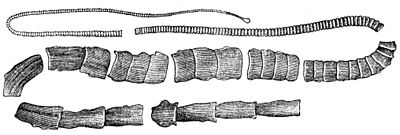
Search
Cyclophyllidea

Tapeworms of the order Cyclophyllidea (the cyclophyllid cestodes) are the most important cestode parasites of humans and domesticated animals. All have multiple proglottid "segments", and all have four suckers on their scolices (heads), though some may have other structures, as well. Proglottids of this order have genital openings on one side (except in the Dilepididae, which have genital openings on both sides), and a compact yolk gland or vitellarium posterior to the ovary.
Families include:
- Dipylidiidae, the most important member of which is Dipylidium caninum, also called the "cucumber tapeworm" or the "double-pore tapeworm"
- Hymenolepididae, including the genus Hymenolepis, a human parasite
- Taeniidae, which consists of livestock parasites in the genus Taenia and parasites that encyst in humans of the genus Echinococcus
- Anoplocephalidae, which includes several tapeworms of horses and a genus of tapeworms of ruminants, the Moniezia
- Davaineidae, which comprises 14 genera, most of which are parasites of birds
- Acoleidae, which comprises two genera that parasitize birds
- Amabiliidae, comprising four genera that parasitize aquatic birds
- Dilepididae, comprising 24 or so genera
- Diploposthidae
- Gryporhynchidae
- Nematotaeniidae
- Progynotaeniidae
- Schistotaeniidae
References
Text submitted to CC-BY-SA license. Source: Cyclophyllidea by Wikipedia (Historical)
Articles connexes
- Taenia saginata
- Cestoda
- Taeniidae
- Hymenolepis microstoma
- Acoleidae
- Rostellum (helminth)
- Taenia solium
- Pinworm (parasite)
- Taenia taeniaeformis
- Schistosomiasis
- Pinworm infection
- Western diamondback rattlesnake
- Strongyloides stercoralis
- List of infectious diseases
- Ascaris lumbricoides
- Joyeuxiella pasqualei
- Taenia (flatworm)
- Davaineidae
- Liver fluke
- Hymenolepis nana
Owlapps.net - since 2012 - Les chouettes applications du hibou

